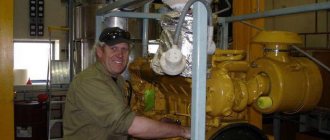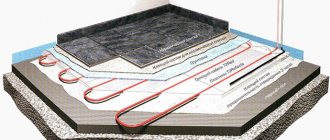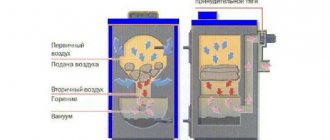Here you will learn:
- Advantages and disadvantages of heated garages
- Electric heating
- Water heating
- Gas
- Circuit on antifreeze
- Solid fuel boiler
- Insulation is the basis for cheap and successful garage heating
- What type of heating is most profitable?
- Installation of a solid fuel boiler with air heating
Economical garage heating can be different for different regions - gas, electric, water, solid fuel. But before choosing options, it is necessary to insulate the garage to reduce heat loss.
Advantages and disadvantages of heated garages
It is clear that a heated garage has enough advantages, but let’s try to summarize them. Of the main ones:
- the car is warm, the engine oil does not thicken, which makes starting the engine easier. This contributes to less wear on components and assemblies and extends the service life of the car;
- locks on car doors will not freeze after washing;
- It is more comfortable to repair a car or carry out carpentry and other work in a warm room.
It can be quite cozy in a warm garage.
But, despite the advantages, warmth in the room at sub-zero temperatures outside can also result in disadvantages, such as:
- increased costs for fuel or electricity;
- installation of even the simplest system, as well as maintenance, will require some time;
- any stove, boiler or gas cylinder in a confined space in a garage is a source of increased danger.
Of course, for a car owner these disadvantages will not seem significant. After all, the condition of your car is more important than the money and time spent, but this cannot be neglected.
This is what improper heating can lead to
Very important! Periodic and timely inspections will help avoid dangerous injuries, burns and even death in the event of an emergency. Be careful during installation and operation. Think over the scheme to the smallest detail before making heating in the garage with your own hands.
Fan heater
Operating principle: a heat exchanger (heating elements or coil) is heated by electricity, air from the room is pumped into the heater by a fan, passed between the heating elements and returned hot to the garage.
- environmental friendliness - the absence of any emissions into the surrounding space during operation;
- ease of adjusting the heating intensity - there are switches for heating modes (turning off some heating elements) and fan rotation speeds;
- small dimensions and mobility - can be installed anywhere in the garage;
- the possibility of focused heating of zones or objects;
- quick heating of the room;
- equipped with automatic shutdown devices in case of overheating or overturning;
- the possibility of additional independent configuration with an electromechanical thermostat to automatically maintain the set temperature in the room;
- low cost of electrical appliances of low and medium power;
- ease of operation and maintenance.
Like any unit, the fan heater also has disadvantages that must be taken into account:
- accompanying heating, a decrease in air humidity in the room;
- the presence of dust accumulation on heating elements, fraught with fire or, at least, an unpleasant odor in the garage;
- noise caused by the operation of the fan;
- increased electricity consumption.
Despite these disadvantages, the use of a fan heater is the most popular heating option for a garage.
Electric heating
Electric heating is a simple and effective option. Does not require arrangement of a water circuit. But electricity must be supplied to the garage (in cooperatives and private houses there are no problems with this, but if the box is located in the courtyard of an apartment building and initially there is no power supplied to it, then there will be problems with this).
Fan heaters
A household fan heater is a device consisting of a heater and a fan that blows out heated air. There are two types:
- With a spiral as a heating element. Such fan heaters are cheaper, less reliable, and burn oxygen. Their operation requires normal ventilation and air exchange. The average cost is from 600 rubles.
- With ceramic heater. A modernized version of the previous ones, they do not burn oxygen, are durable, and do not heat up to the point of incandescence (therefore, the ignition of flammable materials is unlikely). But they are more expensive and their efficiency is lower than that of fan heaters with a spiral as a heating element (by 10 - 20%). The average cost is from 800 rubles.
A fan heater is an electric heater with a fan that blows out heated air and thus cools the heating element. There are models with remote control, automatic thermostat, power regulator
Which fan heater is suitable for heating? You should focus only on power consumption. The optimal option is from 2000 Wh. This is capable of raising the temperature by 5 - 8 degrees in a box with an area of 15 - 20 m² within 30 minutes after switching on.
Ceramic heaters are 10 - 20% more expensive than those that use a spiral as a heating element. But they are better for boxing, that’s why they are preferred
Heated floor system
The option is economical, but the heating cables themselves are not cheap. In addition, you will need to use those that are allowed to be installed in rooms with an aggressive environment (fuel oil, gasoline, oil, solvents, antifreeze - all these substances damage the insulation of conventional cables). But a heated floor system can only be installed if the following conditions are met:
- the heated floor is covered from above with a screed or other flooring material (that will support the weight of the car);
- the heating circuit is laid evenly throughout the room (except for the pit, if there is one); installing it, for example, only around the perimeter will be ineffective.
But such a heating system consumes the least amount of electricity. When using heaters, all the warm air accumulates under the ceiling, while the heated floor ensures uniform heating of the entire internal volume of the box. And if the heating cables are hidden under the screed with a layer of 10 cm or more, then even after turning off the heating the room will be warm for at least 2 - 3 hours (while the heated floor cools down).
A prerequisite is that the underfloor heating system must be laid on a thoroughly insulated base, otherwise the heat will be spent extremely inefficiently
Convector
The oil convector turns out to be the most effective among all other variations of electric heaters. They consume a lot of electricity, but do not make any noise, and are relatively safe (they heat up to only 70 - 80 degrees, so even flammable materials are unlikely to ignite). There are also wall-mounted variations of oil convectors that take up minimal space. If you need to save money, but it is impossible to equip full heating using solid fuel, then convectors are the best choice.
The average price is from 2000 thousand rubles. It is recommended to use models with a power of 2000 Wh and above. It is better to choose models with a built-in thermostat or thermostat (they automatically turn off when the set temperature is reached). If you heat the room to only 15 degrees, the final electricity consumption will be small compared to conventional heaters.
Infrared heaters
Infrared heaters are no less efficient than fan heaters, but consume much less electricity. Their difference is that they do not heat the air, but only emit infrared rays, which heat the surface they hit. The average price of an 800 W heater (optimal performance, it makes no sense to buy with less power) is 2800 rubles and more.
But infrared heaters have a drawback: the radiation they emit has a negative effect on the car's lacquer finish. When turning on such heating, the vehicle will have to be covered with a cover or reflector, but then how to carry out maintenance? So, although such heating is economical, it is not practical.
Infrared heater. It does not heat up during operation, so it can be placed even close to flammable materials. This is an economical option for heating non-residential premises, but is not suitable for a garage
The most economical way to heat a garage with electricity
In the category of heating electrical appliances there are infrared emitters. They themselves do not generate any thermal energy. They simply emit infrared rays, which heat surrounding objects. And they, in turn, exude heat.
It should be noted right away that this is the most economical option in terms of electricity consumption. The most important thing here is to correctly direct the radiation flow. It is better if it is a material that heats up quickly and begins to generate heat. The best option is metal. Therefore, in the garage you can do this - make a metal screen that is hung on the wall or placed on the floor. In essence, the screen is an ordinary steel sheet. The IR heater is suspended from the ceiling or wall and directed towards the laid or suspended screen. That's it, the heating system is ready.
Infrared ceiling heater - a cheap option for electric heating
Attention! People should not be exposed to infrared radiation. It immediately heats up the skin and parts of the body, which is not always good. Take special care of your head.
Infrared heater
The operation of the device is based on the emission of infrared rays, which, upon reaching the surface of objects along the propagation path, heat them, and they, in turn, give off heat to the room. Such devices are sometimes called UFO heaters, but UFO, the common Cyrillic abbreviation of the same name in everyday life, has nothing to do with ultraviolet irradiation.
UFO heaters are available in various sizes and power; they can be on a leg or designed to be attached to a vertical or horizontal base (wall, ceiling). Provided the housing is waterproof or placed under a canopy, infrared heaters can also be used in front of the garage on the street.
- economical electricity consumption;
- ease of operation and installation;
- reliability, safety and environmental friendliness.
The disadvantage of infrared heaters when used in a confined garage space is the effect of infrared rays on a small area, which causes less heat transfer from objects into the air. But when focusing radiation in the direction of the actual zone, these heaters are quite effective.
Important! The significant heating of the housing of UFO heaters during operation requires caution when handling the device in a cramped garage.
Water heating
If the garage is built close to the main building, then the most economical option is to heat the garage in connection with the main heating system.
In this case, you do not need to install a boiler, but you will need to extend the pipeline. This option will lead to loads and an increase in the amount of fuel. If a separate boiler is used, then full power can be used if necessary, and in other cases the equipment operates at rated level.
Water heating can be done not only from a boiler, but also from a stove
Note! To avoid defrosting, you should use antifreeze instead of water in the system.
Electric way
The most common way to heat a garage is electric, but this raises the question of which type of radiator to choose. Infrared heaters are not cheap, but they consume little electricity. Heat guns are good because they heat the room in a matter of minutes, but their downside is that electricity bills will increase greatly; convectors are in the middle.
The most unfortunate is the oil radiator; it heats the room very slowly, but at the same time consumes a lot of electricity. The general advantage of such heaters is that they can be easily rearranged.
Some car enthusiasts assemble the heater themselves; for this they take an old cast-iron radiator and heating element. What power the heating element will have is up to everyone to decide for themselves, and waste oil can be used as a coolant.
It is necessary to take into account that when choosing a heat gun, be prepared for the fact that it will raise the smallest particles of dust into the air, and you will have to breathe through it
Gas
In terms of the cost of energy (natural gas), this is the most economical way to heat a garage, but it is accompanied by hidden costs:
- preparation of design and permitting documentation;
- payment for the work of licensed gas equipment installation specialists;
- costs for ventilation and removal of combustion products;
- costs for routine maintenance of the boiler;
- possibly the necessary construction and subsequent maintenance of the chimney.
Alternatively, to heat the garage you can use infrared gas heaters, heating panels, convectors that consume liquefied propane and butane in cylinders - this eliminates the need to go through the authorities, but adds the problem of providing fuel.
Features of gas heating:
- advantages - high level of automation of the heating system, when using natural gas - constant availability of energy in the main line, cost-effectiveness and high efficiency of gas equipment;
- disadvantages - the presence of a danger factor of explosion, fire or carbon monoxide poisoning.
When using gas heating, the building owner must especially strictly observe safety requirements in his garage.
A good option for a garage is an automatic steam-drip condensing unit, which is up to 15% more economical than other models, as it can operate efficiently at low gas pressure. In the heat exchanger of such a boiler, water from heating with a gas burner turns into steam, and then condenses again into a liquid state, which is accompanied by the release of heat. Such boilers are produced in floor-mounted and wall-mounted versions. For a garage, the second option is preferable, eliminating the possibility of tipping over when performing some work.
Circuit on antifreeze
Continuing the topic of how to heat a garage in winter with your own hands, it should be noted that contour heating is not an entirely hopeless type. What if you fill the circuit not with water, but with antifreeze? Antifreeze is usually used in cars to cool the engine. It does not freeze even at minus 45 degrees, and this is right in our favor.
With such contents, the heating circuit in the garage will not break even in severe frost
For your information! Antifreeze is a toxic liquid, you need to remember this. It can cause burns to the skin and mucous membranes, and the consequences of its impact on the human body can be catastrophic. It is especially dangerous when heated.
If you decide to install heating in your garage using antifreeze yourself, purchase a special mixture for heating systems. It replaces toxic ethylene glycol with propylene glycol, which is not toxic to humans. Such mixtures are more expensive, but they are safe.
It should be remembered that viscous antifreeze heats up and cools more slowly than water. Its shelf life in the system is 5 years. Antifreeze cannot be used for dual-circuit systems.
How to reduce heat loss
Any garage heating system will be unprofitable if it blows from the cracks, so you need to take care of its insulation. The following materials are used for this:
- expanded clay;
- mineral wool;
- glass wool;
- polyurethane foam;
- penoizol.
But the most profitable is polystyrene foam, it has a low price, the level of insulation is not inferior to mineral wool, but at the same time it does not allow moisture to pass through. In addition, it is not susceptible to rotting and various fungi cannot grow on it.
They even insulate the floor with polystyrene foam, but only fill it with cement mortar for strengthening. The garage can be insulated both outside and inside, this is at the discretion of the car owner.
Solid fuel boiler
How else can you heat your garage in winter? There is no need to give up traditional solid fuel. Firewood, coal, pellets, and even manure, if you have enough of it - all this can go into the firebox. You can build a simple oven in the garage with your own hands. By the way, it is the potbelly stoves that have not yet given up their position in the fight against the cold in garage towns. Newfangled electrical systems are still far from popular.
A simple stove can be lined with bricks or stones, this will increase the heat transfer area
Long-burning wood-fired boilers for the home. Principle of operation, scope of application, main manufacturers, selection criteria, how to make it yourself, installation features, recommendations of specialists - read in the publication.
Such a heating device requires constant supervision, but for temporary heating it is suitable like no other. You'll stay warm even if your garage's electricity is cut off for non-payment.
Modern manufacturers offer a wide range of small solid fuel boilers that can be used for car bunkers. They are economical, easy to use and compact.
Important! Remember about fire safety: do not store flammable materials near the boiler.
Important information for your safety
The second possible danger after carbon monoxide poisoning is a garage fire. There are always flammable materials here, including the contents of the car's fuel tank. Neglect of safety measures is fraught not only with the loss of your garage and your beloved horse, but also with a serious lawsuit from neighbors in the parking lot.
For these reasons, we consider it useful to remind you of the basic rules:
- use low-flammable or non-flammable materials for the construction and finishing of the garage structure;
- do not store large amounts of fuel and oil in this room;
- make it a rule to smoke outside;
- do not carry household rubbish into the garage, it will become the main food for the fire;
- keep a fire extinguisher on hand, one day it will save your garage from fire;
- do not install electric heating systems in damp rooms;
- Do not leave your garage heating boiler unattended.
Think about the fact that it would be a good idea to install the simplest smoke detectors in this room.
Insulation is the basis for cheap and successful garage heating
Thermal insulation of a garage is quite a difficult undertaking. Its profitability, profitability, taking into account the price of materials and work, is in question, and is determined by the goals of operating the garage in each specific case.
If you need to constantly maintain a positive temperature in the garage, or very often warm up the garage thoroughly for long-term stays of people, then thermal insulation of the garage is in demand and it must be done to the highest possible quality.
- Insulation of the adjacent strip of soil around the perimeter, 0.5 m wide, with extruded polystyrene foam 5 cm thick becomes mandatory if you plan to use the natural heat of the earth. If it is planned to maintain a high temperature, then external insulation of the soil is also in demand (the ground under the floor will act as a heat insulator), or, by choice, internal thermal insulation of the soil is done.
- Insulation of the outside of all structures - gates, walls - with polystyrene foam 10 cm thick or more, and the roof (floor) - with extruded polystyrene foam 10 cm thick, if water can enter on a flat roof.
- In most cases, it is impossible to carry out insulation from the outside, then insulation is done from the inside, using non-flammable insulation materials (according to standards) and closing them from the internal space with plaster, vapor barriers, in order to avoid the scattering of dangerous mineral wool fibers inside. But in most cases this is ignored and cheap foam (fire hazardous) is used from the inside...
An uninsulated garage will require 2 to 4 times more heating power to achieve the desired temperature. But in practice, initial insulation is performed occasionally and partly due to the large amount of labor involved. Basically, the gates are insulated, sometimes the ceiling is insulated with slabs, as the main cold bridges. Heat losses are compensated for heaters with a power of 3 kW or more...
What type of heating is most profitable?
It all depends on the specific operating conditions and preferences of the garage owner. The cheapest system is a single-pipe water system powered by a gas boiler.
You will have to invest a lot of money in its arrangement, but it is so economical that the costs will be recouped in 1-2 heating seasons. However, this solution is not suitable for everyone.
Gas and diesel appliances equipped with temperature sensors and automation cannot be considered completely energy independent. They require electricity to operate, but no more than a light bulb uses.
You can economically heat your garage using gas cylinders or solid fuel. These options are not suitable if it is not possible to control the operation of the devices, but they are good for heating while the owner is in the garage.
Heat gun
A compact and easy-to-use device that provides quick and effective heating of the garage. It differs from a fan heater in the significantly higher power of heating elements. The device is based on electric heaters and a high-performance fan, which provides intensive air flow to the heating elements, causing rapid distribution of heat in the room.
Connecting high-power heat guns requires a three-phase power supply with a voltage of 380 V; less powerful units are designed for 220 V.
In small garages, the use of heat guns creates dust in the air, so they can be used effectively only if the room is constantly kept clean, including through high-quality finishing of the enclosing structures.
Installation of a solid fuel boiler with air heating
Installation of a solid fuel boiler with air heating (without connecting the liquid circuit) is carried out as follows:
- Preparing the place where it will be installed. The walls and floor nearby (at a distance of at least 50 cm inclusive) are finished with non-combustible material. The ideal option is to install a box made of refractory bricks.
- Chimney installation. It is better to “cut” the hole for the pipe using a powerful hammer drill and a diamond bit for stone. Such transitions in chimneys must be avoided. Over time, the seams can burn out, which will lead to smoke in the room.
- Boiler installation. Recommended performance is about 10 kW. If a pyrolysis boiler is installed, then the chimney should be additionally insulated (otherwise soot will regularly accumulate in it). The boiler and the chimney outlet can be connected with a corrugated metal pipe.
- Fixing the boiler (using dowels on the plates on the bottom). A mandatory item that many people ignore. Fixation allows you to avoid distortions and depressurization with the chimney. It is imperative to check that the boiler is level using a building level.
- Test warm-up (one fuel load). At the same time, the tightness of the connection with the chimneys and the absence of reverse draft are checked.
All work should be carried out in the warm season. In winter, it will not be possible to finish the walls or screed the floor (at temperatures below +10 degrees, building materials of this type lose their properties).
A solid fuel boiler can also be placed outside the garage in an extension; according to many criteria, this is more convenient. But in the garage itself, it is necessary to run a heating circuit or at least a radiator, heated by the boiler. The efficiency of such a system is much lower; part of the heat will be dissipated into the environment rather than entering the room.
In summary, there are a lot of options for economical garage heating systems, but the most profitable option is to install a solid fuel boiler with air heating (popularly referred to as “potbelly stoves”), running on coal, fuel oil, wood or wood briquettes. In this case, one-time heating of a garage of 25 square meters will cost only 40–60 rubles.











